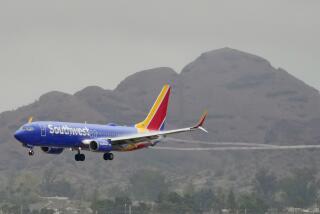Pioneer Western Pilot Recalls Day It All Began : Airline Has Come a Long Way Since 1st Flight in 1926
- Share via
For Alva R. DeGarmo, April 17, 1926, was not a lucky day. He flipped a 50-cent piece and lost. That’s how close he came to being the pilot on Western Airlines’ first flight.
But DeGarmo--now 87 and the last surviving member of Western’s first four pilots--”The Four Horsemen” as they were called--took out the second flight of Western Air Express, the original name of the nation’s oldest air carrier. He reminisced the other day about those early days of flight.
It took six hours to fly between Los Angeles and Salt Lake City with a refueling stop in Las Vegas, a 653-mile flight that now takes just over 1 hour on one of Western’s 82 big jets. So they wouldn’t lose their way, pilots used to follow the Southern Pacific railroad tracks.
“You had to eyeball landmarks to judge your course,” DeGarmo recalled. The return trip was made the next day. That first flight carried 256 pounds of mail.
Incorporated on July 13, 1925, Western’s first airmail flight took off nine months later from Vail Field (in what is now the City of Commerce). That route gave Los Angeles its first transcontinental air service and put Southern California on the airmail map.
Western carried fewer than 300 passengers in 1926, the year that marked the start of scheduled airline service and the year before Charles A. Lindbergh’s first non-stop transatlantic flight from New York to Paris. Today, the airline carries 30,000 passengers a day.
Western, which made a profit of $28,674.19 in its first year, also pioneered the use of weather stations along its routes. At one point, it was the nation’s largest carrier.
Besides DeGarmo, few other people are still around who remember Western’s first takeoff at 8 a.m. on that clear day in April, 1926. One is Katherine Gilpin, who lives in Los Angeles. Now 86, she watched the takeoff from beside the dirt runway.
About 1,000 people had gathered to witness history. As the open-cockpit, single-engine Douglas M-2 rose, it scattered a cloud of dust and pebbles into the air even though the runway had been oiled. A cheer went up from the crowd and people threw their hats into the air. Western was born.
With a new airmail contract authorizing daily flights between Los Angeles and Salt Lake City, the airline consisted of six wood-and-fabric planes and an old hangar that once had been a movie studio.
Carried Mail on Lap
“I felt it was for real; we were getting someplace. Before that flight, there was only barnstorming,” said Gilpin, whose husband, also a pilot, was killed in a plane crash as he flew a mail run to Mexico. “I was pretty proud. At last flying had become a useful, legitimate business.”
Western’s small planes carried only one passenger in those early days--and the passenger had to hold mail sacks on his or her lap. When there was too much mail, the passenger was bumped. Passengers wore flying suits, goggles and a parachute.
DeGarmo recalled that for the first month of its existence, Western was not allowed to carry passengers. Thus, when humorist Will Rogers wanted to fly between Los Angeles and Las Vegas, he went to the post office, bought enough stamps to mail all 180 pounds of himself and made the trip as “airmail.”
More to Read
Sign up for The Wild
We’ll help you find the best places to hike, bike and run, as well as the perfect silent spots for meditation and yoga.
You may occasionally receive promotional content from the Los Angeles Times.






